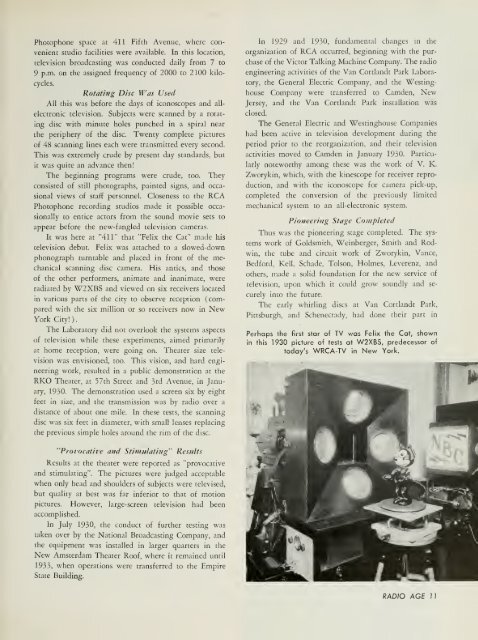Radio Age - 1956, April - 36 Pages, 2.8 MB, .PDF - VacuumTubeEra
Radio Age - 1956, April - 36 Pages, 2.8 MB, .PDF - VacuumTubeEra
Radio Age - 1956, April - 36 Pages, 2.8 MB, .PDF - VacuumTubeEra
Create successful ePaper yourself
Turn your PDF publications into a flip-book with our unique Google optimized e-Paper software.
.<br />
Photophone space at 411 Fifth Avenue, where convenient<br />
studio facilities were available. In this location,<br />
television broadcasting was conducted daily from 7 to<br />
9 p.m. on the assigned frequency of 2000 to 2100 kilocycles.<br />
Rotating Disc Was Used<br />
All this was before the days of iconoscopes and allelectronic<br />
television. Subjects were scanned by a rotating<br />
disc with minute holes punched in a spiral near<br />
the periphery of the disc. Twenty complete pictures<br />
of 48 scanning lines each were transmitted every second.<br />
This was extremely crude by present day standards, but<br />
it<br />
was quite an advance then!<br />
The beginning programs were crude, too. They<br />
consisted of still photographs, painted signs, and occasional<br />
views of staff personnel. Closeness to the RCA<br />
Photophone recording studios made it possible occasionally<br />
to entice actors from the sound movie sets to<br />
appear before the new-fangled television cameras.<br />
It was here at "411" that "Felix the Cat" made his<br />
television debut. Felix was attached to a slowed-down<br />
phonograph turntable and placed in front of the mechanical<br />
scanning disc camera. His antics, and those<br />
of the other performers, animate and inanimate, were<br />
radiated by W2XBS and viewed on six receivers located<br />
in various parts of the city to observe reception (compared<br />
with the six million or so receivers now in New<br />
York City! )<br />
The Laboratory did not overlook the systems aspects<br />
of television while these experiments, aimed primarily<br />
In 1929 and 1930, fundamental changes in the<br />
organization of RCA occurred, beginning with the purchase<br />
of the Victor Talking Machine Company. The radio<br />
engineering activities of the Van Cortlandt Park Laboratory,<br />
the General Electric Company, and the Westinghouse<br />
Company were transferred to Camden, New<br />
Jersey, and the Van Cortlandt Park installation was<br />
closed.<br />
The General Electric and Westinghouse Companies<br />
had been active in television development during the<br />
period prior to the reorganization, and their television<br />
activities moved to Camden in January 1930. Particularly<br />
noteworthy among these was the work of V. K.<br />
Zworykin, which, with the kinescope for receiver reproduction,<br />
and with the iconoscope for camera pick-up,<br />
completed the conversion of the previously limited<br />
mechanical system to an all-electronic system.<br />
Pioneering Stage Completed<br />
Thus was the pioneering stage completed.<br />
The systems<br />
work of Goldsmith, Weinberger, Smith and Rodwin,<br />
the tube and circuit work of Zworykin, Vance,<br />
Bedford, Kell, Schade, Tolson, Holmes, Leverenz, and<br />
others, made a solid foundation for the new service of<br />
television, upon which it could grow soundly and securely<br />
into the future.<br />
The early whirling discs at Van Cortlandt Park,<br />
Pittsburgh, and Schenectady, had done their part in<br />
Perhaps the first star of TV was Felix the Cat, shown<br />
in this 1930 picture of tests at W2XBS, predecessor of<br />
today's WRCA-TV in New York.<br />
at home reception, were going on. Theater size television<br />
was envisioned, too. This vision, and hard engineering<br />
work, resulted in a public demonstration at the<br />
RKO Theater, at 57th Street and 3rd Avenue, in January,<br />
1930. The demonstration used a screen six by eight<br />
feet in size, and the transmission was by radio over a<br />
distance of about one mile. In these tests, the scanning<br />
disc was six feet in diameter, with small lenses replacing<br />
the previous simple holes around the rim of the disc.<br />
"Provocative and Stimulating"<br />
Results<br />
Results at the theater were reported as "provocative<br />
and stimulating". The pictures were judged acceptable<br />
when only head and shoulders of subjects were televised,<br />
but quality at best was far inferior to that of motion<br />
pictures. However, large-screen television had been<br />
accomplished.<br />
In July 1930, the conduct of further testing was<br />
taken over by the National Broadcasting Company, and<br />
the equipment was installed in larger quarters in the<br />
New Amsterdam Theater Roof, where it remained until<br />
1933, when operations were transferred to the Empire<br />
State Building.<br />
RADIO AGE 11
















